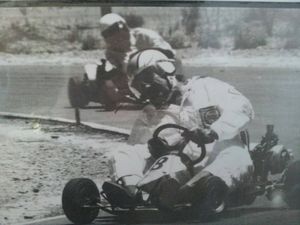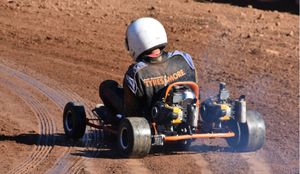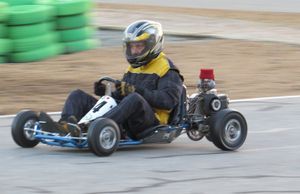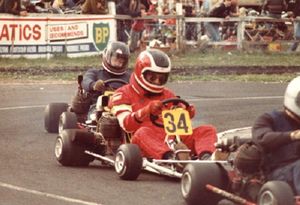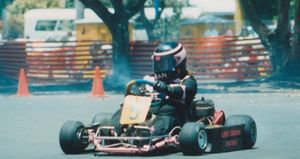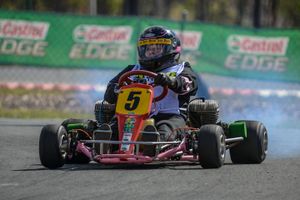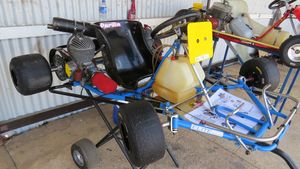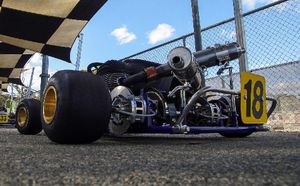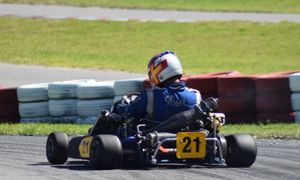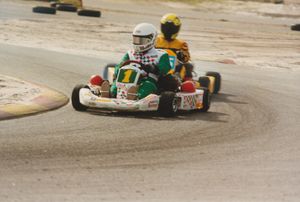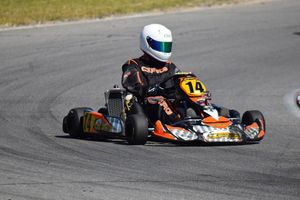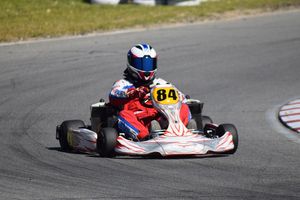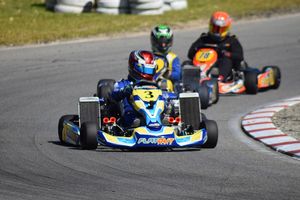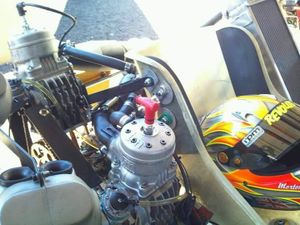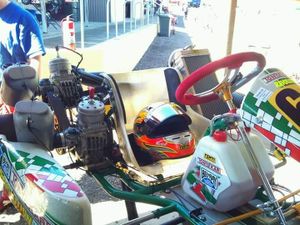The Evolution of a Racing Brute, the Open Class.
14 Apr 2017
Over the years, the twin Super or Open Class has undergone many changes. We have had single engined lower weighted Karts, we have had Twin Engined Karts, and we have even seen Nitrous powered monsters as well. Initially it was the 200cc Class, the 150cc and 125cc classes that were run. Brian Hunter, Robert Hunter and Rod Kretzschmar were the first National Champions in these classes in 1963. During the early years the Hunter brothers, Rod Kretzschmar and Peter Ward were to dominate the class. The ladies were also to be given a class of their own with drivers such as Leslie Smith, Carol Downs, Pat Peck and Elaine Kretzschmar winning their fair share of early Championships. Sadly, by the mid-1970s the Ladies Super Class ceased to exist. WA’s Marlene Dean was one of the last female drivers to win a National Championship.
The AIDKA and earlier AKA Dirt Kart clubs also have various configurations of basically the same thing and later on treaded tyres. No matter what era we have been involved in, the class has raced on bitumen or on the dirt.
Presently, the class has underdone another metamorphosis. The advent of the more recent TAG 125cc Engines sparked an interest in the class again. The lure of the Touch And Go engines have been difficult to resist.
An article in Kart Magazine from October 2003 written Steven Paul Tomlinson, about his Twin FR 125 Rotax / Techno saw the beginning of the more recent evolution of the class into the class that we see today. I am not sure what became of the Kart, but I hope it is not hanging up in some-ones shed gathering dust.
I have become involved in Vintage Kart “racing” over the last two years and have seen a few remarkable Karts on the track. These Karts are driven at the Hurricane Vintage Go Kart Club at regular Club Runs and on the odd practice day. Several of them stand out and I recall these Karts quite vividly. One is the Twin Solo Engined LDR Kart driven by the late and great Marlene Dean for many years. I first saw it at the Bunbury Street Meetings during the early 1990’s. It is still being driven on track today.
The second is the Twin Super owned by Brendan Reed. It is a Techtron Twin, powered by two Parilla TT75 Reed Valve engines. It is a beautiful piece of work and hopefully some of you on the east coast will get to see it one day. Another was a very rare Elite (Excell) / Parilla TT25 powered Super built by Paul Cooper. Sadly, that is now residing in somewhere in the UK.
Another is the beautifully restored twin MCulloch powered Bug Kart owned by Dave Green of Kalgoorlie. It is a wonderful thing to watch on track and the sound it makes is a reminder of what I missed during the 1960s. The Ken Ditchfield owned Twin MCulloch Lancer restored by Colin and Jason Youd is another of the great piece of WA Karting history. Ces Ditchfield had a similar Kart back in the day.
John Pizzaro’s Twin Super was the first great Twin Super I saw charging around at the National Championships held at Geelong in 1992. Twenty Eight Supers ran at that meeting and it remains at the most I have seen on one track at one time. Drivers I recall driving a Super at this meeting were Ray Harrison (Trik / Atomik), Mike Sully (Kali / Rotax), Steve Richards (Dap / Yamaha B5) Robert Grieve (Speed / Parrilla) and Owen Osborne (INT).
I recall heading down to Cockburn International Kartway in late 1996. It was the day after the WA State Championships. Marlene and Les Dean had offered Ian Salvestrin a drive of the legendary Marlene Dean driven Twin Solo /LDR engined Chassis driven by Marlene the previous week-end. They along with Wayne Bell were on hand to give Ian a few tips on what to and what not to do. Ian drove both Marlene and Wayne’s kart. It was a remarkable day for him and he was buzzing all the way home. An article titled “G Force Formula 200 Track Test” was written by Ian and published in Kart Oz Magazine a few weeks later.
Two Twin 200 Supers built in the late 1990’s remain as two on the most remarkable pieces of Karting design and construction artistry that I have ever seen. The first was the second of two Twin Chassis built by Wayne Bell and the other was perhaps the most remarkable. It was the Chassis built by Rex and Simon Wedd. A Twin Tony Kart Chassis with two Vortex Engines. This Kart, driven by Simon won two National Championships at Geelong in 1998 and in Kalgoorlie in 1999. It was an incredible and beautifully crafted Kart and I was lucky enough to be able to sit in (not drive) it at Wanneroo International Kartway one day long ago. It is the BEST Kart I have ever seen and it makes me weep to recall that it was stolen from Simons sister’s shed several years ago. Simon passed away a few years before that and the Kart’s disappearance is still a mystery.
Kai Heller drove a wonderful Twin Super for a few years. It too was a great and wonderful looking Kart. It was just as visually stunning as Simon Wedd’s Twin Super and when the two Karts were on track together, there was not much between them. I believe that chassis is still in use.
Fast forward a few years to the present and the class is alive and kicking. More recently, at the Carnival of Karts in April 2017. Twelve Karts showed up to race, one was a Shifter Kart. But, it was the Twin Super that stole the show with Thomas Sparkes driving a Twin Vortex powered Praga absolutely blitzing the field on that week-end. Several of the drivers had their own unique chassis on track. John Green was driving his Parilla powered SCAR chassis and Thomas Gray was driving a twin 100cc powered DT chassis. Three drivers had Twin Praga Karts over the week-end. The others included CRG x2, Arrow x2, Swiss Hutless x2 and Azzuro chassis.
One of the Karts stands out in this class and that is the beautifully crafted Arrow Twin Super built by Dave Harris. It is powered by two Vortex ROK DVS 125cc engines and it too is a work of art. An accident at the first round of the Western Cup at Wundowie in 2017 meant that Dave had quite a bit of work to do to get the Kart repaired for the next meeting. The apparent damage looked worse than it appeared. The Kart was repaired and turned around quickly and Dave had it back on track smartly in time for Round Two in Geraldton a few weeks ago.
A major supporter of this class in recent times has been Luke Morton. He built the first water cooled Twin Super in Perth nearly 11 years ago. Luke finished building it just before his father Keith passed away and managed to get it on the track and running the day before. The whole family is involved in Karting and Luke’s two children race at the Dirt Trackers Kart Club here in Perth. His wife Caroline organized the first Legends meeting at Wanneroo International Kartway in 2015 and she is actively involved in the family’s racing activities.
Luke has built several Twin Supers in his time and about 10 years ago he built a rather radical looking machine. Two TM Rotary engines power the Kart and he has run it several times in the intervening years. It is has two right hand side engines. Luke has also has built a Twin Rotax Reed Valve Twin and has raced that at the carnival of Karts at Cockburn International Kartway. He is passionate about his Twin Supers and talks about them with great pride. Luke is currently building a Classic Twin Super which he believes will run at the Hurricane Vintage Go Kart Club before the end of the current season.
A lot of work goes into the preparation of these Karts and you can-not simply walk into your local Kart dealer and purchase one off the shelf. A great amount of planning and design goes into each chassis. The choice of engines is a little simpler, but requires a lot of thought. Drivers tell me that an older style Reed Valve engine give you the torque to pull you out of a corner and the similar vintage Rotary engine gives you the top end you need. Some chassis have a combination of both engines if you wish to choose the older style of motor. Many drivers have chosen the more modern engines and use the Rotax or Parilla TAG engines. It will be interesting to see if the PRD Fireball will be used in the near future. It seems as if it is becoming quite a popular alternative to the European engines.
I would love to be around in twenty years’ time to see what drivers come up with by then……Perhaps electric????
